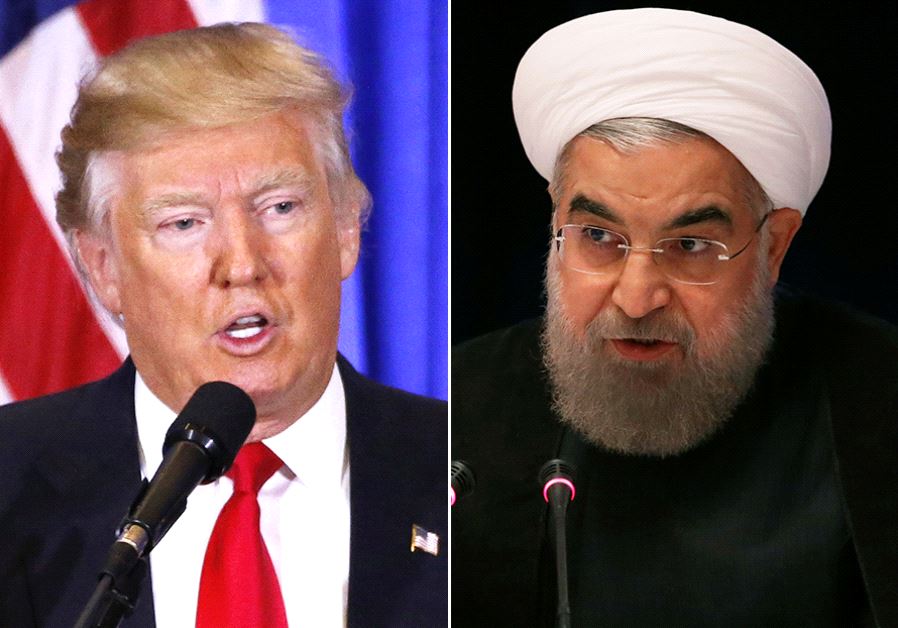For the past two weeks, the U.S. and Iranian officials have ramped up a war of words. Iran’s President Hassan Rouhani warned Donald J. Trump that war with Iran would be the “mother of all wars.” The following day, Trump warned Rouhani in an all-caps retort on Twitter of “consequences the likes of which few throughout history have ever suffered before.” Three days later it was Iran’s turn again when a powerful commander of Iran’s elite Revolutionary Guards warned Trump that if he would begin a war, Iran will end it.
A few days later, the American president softened his tone and suggested that talks with Tehran were imminent. In response, Iranians resorted to a policy of strategic ambiguity by seemingly ruling out any chance of dialogue, yet establishing some back-channel communication through Oman.
To figure out where all this rhetoric will lead to, we need to look into all intents and purposes of the two sides to either (de)escalate tension, maintain status quo, or improve bilateral relations.
On the part of Iran, the country’s anemic economy has pushed people over the edge for the past year. Popular protests have repeatedly broken out in several Iranian cities over the country’s plummeting currency and dramatic rising prices. Additionally, new U.S. sanctions have not only stocked uncertainty but also fueled unrest further across the country.
Such internal turmoil has partly developed the essential ingredients necessary for an outside regime change plan to succeed. Although the current U.S. administration appears to not know what it wants beyond the end of the Islamic Republic, Iranian officials are assured that the wrought aftermath of the collapse of the state is likely to entail Iran’s territorial disintegration, if not turning it into another Syria at the hands of well-funded, highly-armed paramilitaries and armed groups.
Given Iran’s hawks and U.S. regime-change evangelists such as National Security Advisor John Bolton, Secretary of State Mike Pompeo, and U.S. Ambassador to the UN Nikki Haley being at the helm of U.S. foreign policy, Iranian officials would have no choice but to pursue a more cautious path in their dealings with the U.S.
Perhaps, such considerations are what prompted Iranian senior cleric Ali Akbar Nategh Nouri to say that Trump’s offer of new talks should not be categorically rejected.
On the part of the U.S., the worst-case assumption is that President Trump needs to start a war with Iran to first show that he’s sufficiently committed to “Make America Great Again!” and then look as presidential as possible across the aisle to gain him a second term as president of the United States.
Just remember how the missile attack on Syria in April 2018 drew relative praise from some Republicans and few Democrats. Further, there is no doubt that Trump’s “war cabinet” and the U.S. regional allies (Saudi Arabia, Israel, and the United Arab Emirates) have stepped up their efforts to urge Trump to bomb Iran.
However, there are a few reasons that dissuade Trump from resorting to military action against Iran.
First, given the U.S. involvement in the failed war on terror for the past 17 years, it is way too hard for President Trump to sell another war with a Muslim country to the American public. Trump’s “America First” in foreign policy is characterized by financial concerns. The 17-year war on terror has already cost the U.S. 5.6 trillion dollars. As a conflict with Iran would require a few more trillions of dollars, President Trump would be disincentivized to go down the path of war.
Additionally, as European allies have already sharply criticized the American president for wrecking the Iran nuclear deal, Trump would have a hard time forging a coalition for a U.S.-led war against Iran. After all, it is not easy for a deal-breaker to justify an unnecessary war against a country which has, so far, fully complied with a multilateral deal that consists of the most intrusive inspection regime in the world.
Last, despite America’s invincibility and military superiority, Iran’s asymmetric capabilities could pack quite a punch, according to military experts. Given Iran’s strategic visibility and influence in the Middle East, a military attack would trigger a broader regional conflict that would seriously put American interests in harm’s way. Therefore, to save the American prestige as well as U.S. taxpayers’ money, Trump would be less likely to push for a military attack on Iran.
As discussed above, if a host of challenges provide mutual deterrence for both the U.S. and Iran to avoid military confrontation the two sides might, once again, sit down at the negotiating table.
For the attention-seeking U.S. president, who is determined to go to great lengths to undo Barack Obama’s legacy, the pageantry and showmanship of a “better” deal with Iran means a great achievement. Also, in as much as a military attack would yield unity among a sizeable portion of Iranians in support of the current regime, an offer of negotiations would strengthen voices of dissent that have criticized the Iranian regime’s anti-American sentiments for years.
Likewise, Iranians have no reasons to hesitate to seize the opportunity to trade off the 159-page nuclear deal for a barely two-page declaration similar to what Trump has signed with the North Korean leader in Singapore.
By agreeing to meet the American president, Iranian officials might seem to play into the hands of Trump in his salesman mode; yet, similar to Kim Jong-Un, it would gain them recognition as an equal by the leader of the world’s sole superpower.
Nonetheless, as the landmark 2015 deal came to fruition after 12 years of painstaking negotiations, we can assume that forging another deal between the U.S. and Iran will not be an easy job.
If the U.S. and Iran decide to meet one-on-one on the sidelines of the UN General Assembly next month to negotiate an agreement, that would be “THE MOTHER OF ALL DEALS THE LIKES OF WHICH FEW THROUGHOUT HISTORY HAVE EVER SEEN.”


